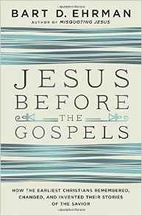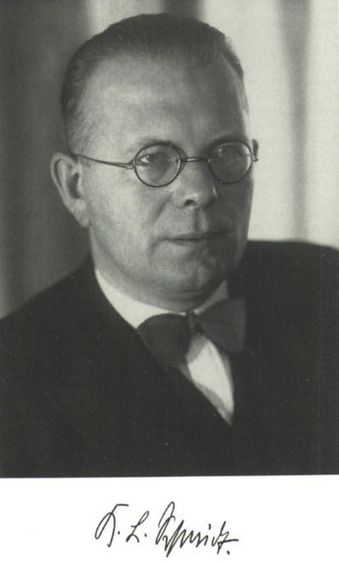In my previous post, I discussed the basic element of Bart Ehrman’s understanding of Maurice Halbwachs, the founder of the study of collective memory. This time, I’d like to focus on his remarks concerning Formgeschichte (form criticism) as it applies to the New Testament in general and memory theory in particular.
Basic Element 2: Form Criticism
[youtube=https://www.youtube.com/watch?v=V8lT1o0sDwI]
“Forget it — he’s rolling.”
♦ Dibelius said what?
 Bart gets on a roll in Jesus Before the Gospels, as he describes the early form critics. He writes:
Bart gets on a roll in Jesus Before the Gospels, as he describes the early form critics. He writes:
The authors of the Gospels—all of them, not just Mark—wrote down stories that had been passed along by word of mouth for years and decades before they wrote. For that reason, when the Gospel writers produced their accounts, they were not simply inventing the stories themselves; but they were also not recording what actually happened based on direct testimony. They were stringing together stories that had long been circulating among the Christian communities. For [Martin] Dibelius, “stringing together” is precisely what the Gospel writers did. The Gospel stories are “pearls on a string.” The authors provided the string, but they inherited the pearls. (Ehrman, 2016, p. 46, emphasis mine)
It would appear that Ehrman wishes to attribute the well-known metaphor, pearls on a string, to Martin Dibelius. When I first saw it, I thought, “I must not be reading that right.” But then I noticed a post on his blog, entitled “The Next Step: Redaction Criticism,” in which he wrote:
For these form critics, the Gospel writers themselves were relatively unimportant and uninteresting. They took stories available to them and put them into a roughshod narrative, more or less like “putting pearls on a string,” as Dibelius likened it. The pearls — the stories themselves — were what mattered. In a pearl necklace, who cares about the string? (emphasis mine)
Oh dear. This isn’t the sort of mistake where some random slob on the web writes “there” when he meant “their.” This is more like a scholar of American history saying that George Washington wrote the Declaration of Independence. In other words, not just wrong, but weirdly wrong — spit-take wrong, stop-in-your-tracks-and-stare-with-your-mouth-open wrong.
♦ They don’t read Schmidt
If you didn’t recall who should receive credit for the “pearls on a string” allusion, that’s all right. You probably aren’t earning your living as an NT scholar and university professor. The form critic most commonly associated with the metaphor is Karl Ludwig Schmidt. You may remember him from my series on The Genre of the Gospels. Today’s scholars know practically nothing about Schmidt. That studied ignorance is no accident, but is the result of “years of indifference and hostility” (to quote John Riches) to form criticism by English-speaking scholars.
They know very little about the form critics in general, except what they glean from secondary sources. When it comes to Schmidt, they know maybe three things:
- His name (although some of them probably think his first name is “K. L.”).
- The name of his magnum opus (Der Rahmen der Geschichte Jesu).
- The fact that he coined the term “pearls on a string” to describe the gospels.
Sadly, Ehrman could remember only the first two, although when referring to the title, he misspells “Jesu” as “Jesus.” To his credit, he did remember Schmidt argued that the author of Mark’s gospel used small story nuggets (pericopae) from the existing oral tradition, and placed them in his own rather sparse narrative framework.
Still, I was amazed that he forgot a basic fact that any undergrad in Biblical Studies should know, namely Schmidt’s pearls. At least that’s how I remembered it. But then I began to doubt myself. Maybe the Germans really did bomb Pearl Harbor. Maybe J.S. Bach really did write Für Elise. Maybe Dibelius really did invent the pearl-on-a-string trope.
I had to find out for sure.
♦ Poor scholarship abounds
At first, I was too lazy to get up and rummage through my library, so I Googled “string of pearls” related to “gospels” or “New Testament.” I assumed the grand Bible scholars of the past 100 years would tell me exactly where to find the phrase in Schmidt’s works, chapter and verse. Naturally, I was wrong.
Often, scholars will use the phrase and mention Schmidt briefly, but neglect to provide any citation whatsoever. Other scholars will provide a citation, but only the title of the book, and no page number. Who would engage in such scholarly malpractice? Oh, you’d be surprised.
For example, Richard Burridge wrote:
In 1919, Schmidt demonstrated that the differences between the synoptic gospel accounts can be seen most clearly in the links or seams by which the various stories are joined. From this he concluded that these units, or pericopae, circulated independently within the oral tradition and were then strung together, like so many pearls on a piece of string, by the evangelist.12 (Burridge, 2004, p. 6, emphasis mine)
Look! He provided a footnote. On which page or pages would we find this information?

That’s none of our business. So, somewhere in this 322-page book, Karl Schmidt said something about independent pericopae and pearls. How nice.
Burridge is far from unique. In Handbook for the Study of the Historical Jesus, Joanna Dewey cites Schmidt’s work, writing:
[F]orm critics argued that there was no connected narrative of Jesus’ life and ministry until it was patched together by Mark. The literary analysis of Mark by K. L. Schmidt showing that Mark was constructed like pearls on a string was particularly influential on this point.21 (Dewey (Porter), 2011, p. 1828, emphasis mine)
Oh, now that does look promising. Let’s take a look at footnote 21.

Again, no page numbers. What these authors are telling us, essentially, is: “Here’s the title of a book I’ve never read.”
At least they got the title right. Bart Ehrman did not. For some reason, he spells “Jesu” wrong and oddly combines the original publishing date (1919) with the reprint publisher’s name, which also misspelled. It’s “Wissenschaftliche Buchgesellschaft,” and they didn’t exist until 1949.

“Buchgesenschaft” is not a word. I know typos happen; I’m plagued by them myself. But how do you manage to misspell a word in the title, misspell the name of the publisher, and get the date wrong all at the same time?

1891-1956
♦ What did Schmidt actually say?
Until I began my search, I’d forgotten that Schmidt had mentioned “pearls” in his later book, The Place of the Gospels in the General History of Literature. In it, he grumbled about the dreadfully awful Jesus novels of his time.
The cultic content of the gospels gets buried alive in a novel. The pearls of the individual gospel traditions, which sparkle with variety when loosely strung together, get trampled into a paste and molded into a different entity. The material of the pearls is not totally lost, but their beauty is. Read any Jesus novel – you will gladly go back to reading the gospels. (Schmidt, 2001, p. 80)
But we find the real Holy Grail in Schmidt’s writing in Der Rahmen Der Geschichte Jesu (The Framework of the History of Jesus). This groundbreaking work has never been translated into English, which explains why in Great Britain, the Commonwealth, and the U.S. it is rarely read and poorly understood.
What he actually said was this:
Im Bilde könnte man das so veranschaulichen: die Mk-Darstellung ist nicht eine Perlenkette von lose aneinandergereihten Perlen, zwischen denen man andere bald andere bald hier, bald da einschieben kann, sondern ein Haufen von nicht aufgereihten Perlen, wenn auch ab und zu mal einige Perlen zusammengehören.
[In English:]
We could illustrate it with this metaphor: the Markan account is not a necklace made of loosely strung-together pearls between which we can squeeze one sometimes here, sometimes there, but rather a pile of unstrung pearls, even if some pearls will match up from time to time. (Schmidt, 1919, p. 281, emphasis mine)*
Here we see that Schmidt had ambivalent thoughts on the subject. He could joke about Jesus novels crushing the loose string of sparkling pearls, or he could lament that Mark’s gospel was decidedly not a series of a nicely sized and spaced nuggets, but instead resembled, more or less, a random heap.
♦ Only a man . . .
In light of his actual words — “the Markan account is not a necklace“ — it now seems rather jarring to read the words of Morna D. Hooker, in The Message of Mark.
It will not, I hope, be regarded as a sexist remark if I suggest that only a man could have used the phrase ‘like pearls on a string’ to suggest a haphazard arrangement of material. Any woman would have spotted the flaw at once in the analogy: pearls need to be carefully selected and graded. And gradually it has dawned on New Testament scholars that this is precisely what the evangelists have done with their material. (Hooker, 1983, p. 3)
She does not explicitly credit the pearls analogy to Schmidt. In fact, she only mentions him in a footnote in relation to C. H. Dodd. In a chapter named “Like Pearls on a String,” we learn about Dodd’s theory of Markan order, but we learn nothing of Schmidt’s. Of course, it turns out that Schmidt was Dodd’s punching bag in his paper, “The Framework of the Gospel Narrative” (warning: PDF), but we obviously don’t need to know anything about Schmidt, except for a short sentence in the back of the book. And why should we care?
I’m not saying I agree with Schmidt on the supposed chaotic structure of Mark. I suspect he held much subtler views than today’s scholars credit him for. For example, in the introduction he explains that Mark’s framework was not based on chronology or topography, but on theology. I am saying it would be nice if today’s scholars didn’t condense his (unread) 300-page explanation into a single sentence.
What were Schmidt’s contributions?
In Jesus Before the Gospels, Ehrman writes:
If the earliest of our Gospels is not just historical but also theological, what about the traditions about Jesus before the Gospels were written? That became the concern of the form critics, scholars especially active in the 1920s, who wanted to shift the focus of attention away from the written Gospels to the traditions lying behind them. The scholar who began this shift was Karl Ludwig Schmidt, who was very soon eclipsed in importance by two of the real stars among twentieth-century biblical scholars, Martin Dibelius and Rudolf Bultmann. (Ehrman, 2016, p. 45, emphasis mine)

1883-1947
♦ The forerunner?
I’m not quite sure why Ehrman wants to put Schmidt first, since his Framework came out in the same year as Dibelius’s Die Formgeschichte des Evangliums (Eng. tr.: From Tradition to Gospel) — 1919. And he apparently forgot about the book Dibelius wrote on John the Baptist, Die urchristliche Überlieferung von Johannes dem Täufer (The Early Christian Tradition of John the Baptist).
In the foreword of this 1911 work, he writes:
For the goal of my work I had in mind less the reconstruction of sources than the appreciation of the process of literary development. So far we can see two results from this work: the history of the form [literally, die Geschichte der Form] of the accounts of wandering missionaries [i.e., oral tradition] up until the powerful work of the Fourth Gospel and the history of their path from Jerusalem to the West. (Dibelius, 1911, p. iii, [my translation])
Later on, he talks about following the development of the stories (die Perikope) from the oral tradition (mündliche Überlieferung) into their written forms (see, e.g., p. 4). Eventually, he will argue that the context of the transmission of the oral tradition was preaching — an argument he would elaborate on further in From Tradition to Gospel.
If you examine the front matter of his John the Baptist book at HathiTrust, you’ll see that one of the editors was Hermann Gunkel, the founder of form criticism. Not that we should take anything away from Schmidt’s achievements, but Dibelius is at the very least his contemporary, if not the forerunner in the field of Form Criticism in the New Testament. This book, I contend, is the very first example of the use of form-critical methods in a New Testament context, which predates Eduard Norden’s Agnostos Theos: Untersuchungen zur Formengeschichte religiöser Rede, by two years.
♦ The genre of the gospels
So what exactly were Schmidt’s major contributions? According to Bultmann:
The first task of form criticism is to describe the literary character of the gospels as a whole and to determine their place in the general course of the history of literature. Its second task is to describe the history of the traditional material which has been incorporated into the gospels, from its preliterary origins up to the point at which it took a fixed literary form in the different gospels. (Bultmann, 1971, p. 86)
To fulfill the first task, K. L. Schmidt wrote the definitive form-critical work on the subject: The Place of the Gospels in the General History of Literature. In it, he explains that the gospels are collections of stories hung loosely on an artificial framework. In a later essay he would write:
Looking at the matter as a whole, one can only speak of an outline of the life of Jesus, which is a secondary editorial addition. The gospels contain not the life-story of Jesus, but stories about Jesus. (Schmidt, 1971, p. 98)
Once it became clear that the gospels were folk literature and that the evangelists had constructed them from existing, separate stories, the task remained to explain how they did it, and, equally important, how do we differentiate the redactional frame from the stories they inherited?
The distinction of traditional from editorial material is the real subject of K. L. Schmidt’s Der Rahmen der Geschichte Jesu (1919). His work is a thorough-going and conclusive discussion of the earlier position, especially [Friedrich] Spitta’s ingenious but misleading suggestions. (Bultmann, 1994, p. 3)
♦ The remembrance of things pasta?

When Ehrman says after 1919 Schmidt “was very soon eclipsed” by Bultmann and Dibelius, we shouldn’t imagine that he disappeared from view. In the English-speaking world, Schmidt is known only indirectly, through the lens of pious, conservative scholars like C. H. Dodd. Schmidt’s Framework provides footnote fodder for modern works, but that’s about it. Scholars quote secondary sources and they write footnotes with no page numbers. Do other academic fields permit this sort of thing?
Today’s scholars have a collective memory of Karl Ludwig Schmidt in which he wrote this seminal work that had something vaguely to do with a framework of something or other. Or was it noodles? Their memory of form criticism in general is not much better.
By the way, I’m only half-joking about the noodles. Here’s a footnote from Birger Gehardsson’s Memory and Manuscript:
![]()
He may have fallen into the modern memory hole, but Schmidt was quite active throughout the 1920s. Besides his 1923 work, The Place of the Gospels, Schmidt wrote two articles from the form-critical perspective in the highly influential second edition of Religion in Geschichte und Gegenwart (1927-1932) (sometimes called “R.G.G. 2“):
- “Formgeschichte” vol 2, pp. 638-640
- “Jesus Christus.” vol 3, pp. 110-151
You can find the English translation of the second work in Twentieth Century Theology in the Making, pp. 93-168.
♦ The context of the transmission of Christian oral tradition
Because they don’t read Schmidt, most of today’s scholars have likely overlooked this important insight from almost a century ago:
Meines Erachtens kann die Bedeutung des urchristlichen Kultes, der gottesdienstlichen Praxis für den Werdegang der Evangelienliteratur nicht hoch genug eingeschätzt werden. Die älteste Jesusüberlieferung ist kultisch bestimmt, daher bildhaft und übergeschichtlich.
I believe that the importance of the Christian cult and its worship practices for the development of gospel literature cannot be overestimated. The oldest Jesus tradition is determined by the cult, and thus is image-rich and transhistorical. (Schmidt, 1919, p. vi, [my translation])
If the stories about Jesus were transmitted orally over some period of time between the time of Jesus and the writing of the gospels, we need to know how they were transmitted. Were there any controls? What pressures from the cult would lead to memory distortion? Schmidt believed that Christians maintained their traditions within the context of worship and the cultic rites of baptism and the Eucharist. Is that a valid conclusion?
Next time
In the next installment, we’ll look more closely at the presumed oral tradition behind the gospels. Ehrman uses the phrase “word of mouth” 13 times in Jesus Before the Gospels. Is he right to compare the passing of traditions in early Christianity to the informal, chaotic spread of rumors from person to person?
* I would like to thank my friend, Werner Saemmler-Hindrichs, for his help in translating this sentence.
Bultmann, Rudolf
“The Gospels (Form),” in Twentieth-Century Theology in the Making, vol. I: Themes of Biblical Theology, ed. Jaroslav Pelikan, Harper, 1971
The History of the Synoptic Tradition, Hendrickson, 1994
Burridge, Richard
What Are the Gospels?: A Comparison with Graeco-Roman Biography, Wm. B. Eerdmans Publishing Co., 2004
Dewey, Joanna
Handbook for the Study of the Historical Jesus, ed. Stanley Porter, Brill, 2011
Dibelius, Martin
Die urchristliche Überlieferung von Johannes dem Täufer (The Early Christian Tradition of John the Baptist), Vandenhoek & Ruprecht, 1911.
From Tradition to Gospel (Die Formgeschichte des Evangeliums), Lutterworth Press, 1987
Ehrman, Bart D.
Jesus Before the Gospels: How the Earliest Christians Remembered, Changed, and Invented Their Stories of the Savior, HarperOne, 2016
Hooker, Morna
The Message of Mark, Epworth Press, 2007
Schmidt, Karl Ludwig
Der Rahmen der Geschichte Jesu: literarkritische Untersuchungen zur ältesten Jesusüberlieferung, Trowitzsch und Sohn, 1919.
“Jesus Christ,” in Twentieth-Century Theology in the Making, vol. I: Themes of Biblical Theology, ed. Jaroslav Pelikan, Harper, 1971
The Place of the Gospels in the General History of Literature, University of South Carolina Press, 2001.
Tim Widowfield
Latest posts by Tim Widowfield (see all)
- How Did Scholars View the Gospels During the “First Quest”? (Part 1) - 2024-01-04 00:17:10 GMT+0000
- The Memory Mavens, Part 14: Halbwachs and the Pilgrim of Bordeaux - 2023-08-17 20:39:42 GMT+0000
- The Memory Mavens, Part 13: The Purpose of Halbwachs’s La Topographie - 2023-05-22 16:15:00 GMT+0000
If you enjoyed this post, please consider donating to Vridar. Thanks!

Very interesting that modern New Testament scholarship in some ways resembles that game of Telephone where the original has become distorted as it passes from one person to the next.
In some cases we have distorted personal memory, like Bart’s idiosyncratic mistake of thinking Dibelius came up with the string of pearls metaphor. What’s odd is that they can make mistakes like that, and nobody notices.
In other cases we have certain giants of the field like C. H. Dodd and even Morna Hooker who promulgate the “appropriate response” to form criticism — namely, that it was created by a bunch of guys in Germany who were “too skeptical” and who took it all “too far.” In this way we get a received, official response that’s socially constructed, and, by the way, which stands the test of time in the English-speaking world. We Brits and Americans just love it when we say we’re taking the sensible, “middle road.” By God, we’re such a practical, pragmatic bunch.
We’re not radicals like those Germans, are we?
I found this criticism of Ehrman too petty, Tim. We get your point: contemporary English-speaking NT scholars don’t read Schmidt. There’s a lot of German form criticism that they don’t read or understand, and what little they do read is often treated with hostility. But a misquotation of one phrase (“pearls on a string”) is surely the least of their problems in this area.
While speaking for myself, Andrew. and not for Tim, I’d have to agree with your last point: Yes, it is. And one would expect the Anglophone NT scholars (including especially the American ones) to get the little things right. After all, the gospels do contain that line, “He who is not faithful in the least of these things…” and American NT scholars on average believe in the gospels more than those in other countries.
Not petty at all. It is indicative of the underlying problem. There are certain catch phrases in all fields of study that everybody knows. They’re cliches, really. Dibelius is simply not known for “pearls on a string.”
If I wrote in a science blog — “As Erwin Schrödinger said, ‘God does not play dice!'” — I would be inundated with comments and emails asking me if I was blogging while high.
We all make mistakes. I do it all the time! But check out the acknowledgments at the end of the book. Ehrman asked Chris Keith, Zeba Cook, and Mark Goodacre to look over the draft. He had numerous people from the UNC faculty look it over. He thanks three of his graduate students for their assistance. He singles out at least 10 more people, blog subscribers, who took him up on the invitation (for a fee) to read and comment on the manuscript. Nobody noticed.
He said the same thing on his blog, which gets tens of thousands of hits every day. And nobody noticed.
The underlying problem that it reveals is not just the of ignorance of form criticism, but the complacency about that ignorance. More than that, because form criticism provides the basis for Ehrman’s understanding of the period of oral tradition, it really does matter whether he understands these topics. (Again, he is not unique, but it’s nonetheless disturbing.)
My next topic will be about oral tradition, and we’ll see that his assumptions about its transmission and the context of that transmission affect his analysis and conclusions.
You do indeed make mistakes all the time. This one is almost intentional, I’d say: Bard D. Ehrman in the bibliography. And while I’m at it, biblical criticism certainly isn’t a social science. But your point stands, even the humanities should be able to provide page numbers in citations.
Thanks for pointing out my “Bard” mistake. I commit more errors than you can shake a spear at.
I’ve always said, “The man who cuts his own hair has a fool for a barber.” I proofread my own stuff, which explains the goofs.
I think the “Bard” lapsus calami is a nice example of what Freud called Fehlleistungen. Many of these ‘faulty actions’ are not accidental, but they have a meaning and can be interpreted.
In this case, it betrays that you consider Ehrman to be similar to a minstrel poet who composed and recited verses celebrating the legendary exploits of chieftains and heroes.
Some of us labor under the illusion that we can give Freud the slip.
Mark, I changed it to “academic fields,” which is what I think I was going for in the first place until I heard those voices in my head.